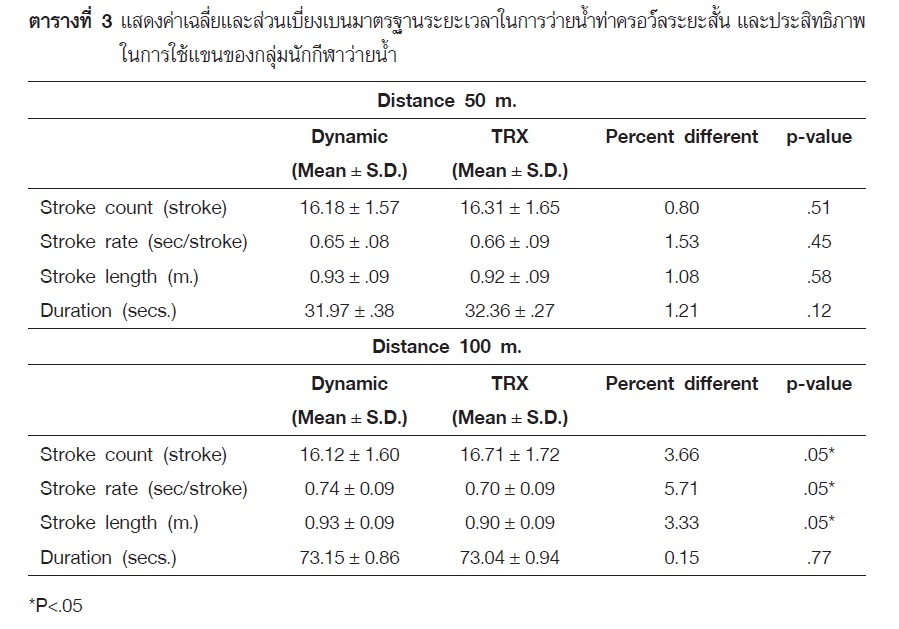ผลการอบอุ่นร่างกายแบบมีแรงต้านและการอบอุ่นร่างกายแบบเคลื่อนไหวในนักว่ายน้ำที่มีค่าดัชนีมวลกายแตกต่างกันต่อประสิทธิภาพการใช้แขนและระยะเวลาของการว่ายน้ำในท่าครอว์ลระยะสั้น
Main Article Content
บทคัดย่อ
วัตถุประสงค์ : เพื่อเปรียบเทียบประสิทธิภาพของการอบอุ่นร่างกายด้วยอุปกรณ์แบบแขวน (TRX) และการอบอุ่นร่างกายด้วยการยืดกล้ามเนื้อแบบเคลื่อนไหว (Dynamic stretching) ในนนักกีฬาว่ายน้ำที่มีค่าดัชนีมวลกายแตกต่างกันต่อประสิทธิภาพการใช้แขนและระยะเวลาในการว่ายน้ำท่าครอว์ลระยะสั้น
วิธีดำเนินการวิจัย : เป็นการศึกษากึ่งทดลอง (Quasi- Experimental Design) กลุ่มตัวอย่างเป็นนักกีฬาว่ายน้ำ ระดับเยาวชนอายุ 13.74±1.03 ปี จำนวน 32 คน เพศชาย 19 คน อายุ 14.06±1.90 ปี เพศหญิง 13 คน อายุ 13.27±0.93 ปี แบ่งเป็น 3 กลุ่มโดยใช้ค่าเปอร์เซ็นต์ไทล์ของดัชนีมวลกาย (BMI; Class 1, Class 2 และ Class 3) โดยอาสาสมัครทำการอบอุ่นร่างกายบนบกสองรูปแบบคือ ด้วยอุปกรณ์แบบแขวน (TRX) และด้วยการยืดกล้ามเนื้อแบบเคลื่อนไหว (Dynamic stretching) โดยทั้งสองแบบ ทำร่วมกับการอบอุ่นร่างกายแบบปกติ (Conventional warm-up) จากนั้นทำการทดสอบระยะเวลาในการว่ายน้ำท่าครอว์ลระยะ 50 และ 100 เมตร และทดสอบประสิทธิภาพในการใช้แขนในระยะ 15 เมตรก่อนเข้าเส้นชัย วิเคราะห์ข้อมูลทางสถิติโดยใช้ One-way analysis of variance และทดสอบความแตกต่างเป็นรายคู่โดย Bonferroni post-hoc test กำหนดระดับนัยสำคัญทางสถิติที่ .05
ผลการวิจัย : นักกีฬาที่มีค่า BMI ใน Class 2 ซึ่งมีค่า BMI อยู่ในช่วง 18.01-20.90 kg/m2 มีระยะเวลาในการว่ายน้ำดีที่สุดทั้งในระยะ 50 และ 100 เมตร การอบอุ่นร่างกายทั้งสองแบบไม่ส่งผลต่อระยะเวลาในการว่ายน้ำ อย่างไรก็ตาม การอบอุ่นร่างกายแบบแขวนทำให้จำนวนรอบของการว่ายต่อนาที (Stroke rate) และระยะทางของวงจรการว่าย (Stroke length) ลดลง เมื่อเปรียบเทียบกับกลุ่มการยืดกล้ามเนื้อแบบเคลื่อนไหวอย่างมีนัยสำคัญทางสถิติที่ระดับ P<0.001
สรุปผลการวิจัย : การอบอุ่นร่างกายด้วยอุปกรณ์แบบแขวน (TRX) ช่วยเพิ่มประสิทธิภาพการใช้แขน เมื่อเปรียบเทียบกับการอบอุ่นร่างกายแบบเคลื่อนไหว แตกต่างกันโดยไม่ขึ้นอยู่กับค่าดัชนีมวลกายของนักว่ายน้ำ
Article Details
เอกสารอ้างอิง
Beanland, E., Main, L.C., Aisbett, B., Gastin, P., and Netto, K. (2014). Validation of GPS and accelerometer technology in swimming. Journal of Sciences and Medicine in Sport, 17(2), 234-238.
Fong, S. S. M., Tam, Y.T., Macfarlane, D.J., Ng, S. S. M., Bae, Y.-H., Chan, E. W. Y., and Guo, X. (2015). Core muscle activity during TRX suspension exercises with and without kinesiology taping in adults with chronic low back pain: implications for rehabilitation. Evidence-Based Complementary and Alternative Medicine, 2015, 1-6.
Gagnon, C. M., Steiper, M. E., and Pontzer, H. (2018). Elite swimmers do not exhibit a body mass index trade-off across a wide range of event distances. Proceeding Royal Soceity, 285(1882), 1-5.
James, L. P., Gregory Haff, G., Kelly, V. G., Connick, M. J., Hoffman, B. W., and Beckman, E. M. (2018). The impact of strength level on adaptations to combined weightlifting, Plyometric, and ballistic training. Scandinavian Journal of Medicine and Sciences in Sports, 28(5), 1494-1505.
Knechtle, B., Knechtle, P., & Kohler, G. (2008). No correlation of anthropometry and race performance in ultra-endurance swimmers at a 12-hours-swim. Anthropologischer Anzeiger, 66(1), 73-79.
LaRoche, D. P., Kralian, R. J., and Millett, E. D.(2011). Fat mass limits lower-extremity relative strength and maximal walking performance in older women. Journal of Electromyography and Kinesiology, 21(5), 754-761.
Lim, J. U., Lee, J. H., Kim, J. S., Hwang, Y. I., Kim, T.-H., Lim, S. Y., Rhee, C. K. (2017). Comparison of World Health Organization and Asia-pacific body mass index classifications in COPD Patients. International Journal of Chronic Obstructive Pulmonary Disease, 12, 2465-2475.
McGowan, C. J., ThomPson, K. G., Pyne, D. B., Raglin, J. S., and Rattray, B. (2016). Heated jackets and dryland-based activation exercises used as additional warm-ups during transition enhance sprint swimming Performance. Journal of Sciences and Medicine in Sport, 19(4), 354-358.
McCullough, A. S., Kraemer, W. J., Volek, J. S., Solomon-Hill, G. F., Jr., Hatfield, D. L., Vingren, J. L., Maresh, C. M. (2009). Factors affecting flutter kicking speed in women who are competitive and recreational swimmers. The Journal of Strength and Conditioning Research, 27(3), 2130-2136.
Messinis, S., Beidaris, N., Messinis, S., Soultanakis, H., Botonis, P., and Platanou, T. (2014). Swimming stroke mechanical efficiency and physiological responses of 100-m backstroke with and without the use of paddles. Journal of Human Kinetics, (40), 171-180.
Mok, N. W., Yeung, E. W., Cho, J. C., Hui, S. C., Liu, K. C., and Pang, C. H. (2015). Core muscle activity during suspension exercises. Journal of Science and Medicine in Sport; Pro Quest Health & Medical Complete, 18(2), 189-194.
Moran, M. (2014). The Effects of static stretching warm-up versus dynamic warm-up on sprint swim performance. Journal of Swimming Research, 22(1), 1-9.
Patil, D., Salian, S., and Yardi, S. (2014). The effect of core strengthening on performance of young competitive swimmers. International Journal of Science and Research, 3(6), 2470-2477.
Power, S. K., and Howley, E. T. (2004). Exercise Physiology: Theory and application to fitness and Performance. 5th ed. Boston : McGraw-Hill.
Samukawa M. (2011). Management of patellar tendinosis in a freestyle mogul skier. International Journal of Athletic Therapy and Training, 16(2), 12-15.
Sawdon-Bea, J., and Benson, J. (2015). The effects of a 6-week dry land exercise program for high school swimmers. Journal of Physical Education and Sports Management, 2(1), 1-17.
Schilling, B. K., and Stone, M. (2000). Stretching: acute effects on strength and power performance. The Journal of Strength and Conditioning Research, 22(1), 44-47.
Sedeaud, A., Marc, A., Schipman, J., Tafflet, M., Hager, J. P., and Toussaint, J. F. (2012). How they won rugby world cup through height, mass and collective experience. British Journal of Sports Medicine, 46, 580-584.
Taratip K. (2014). Effect of the rigorous oral care capabilities applied program onto parents’ behavior in dental health care of preschool children at the Ban Ta-dob Child Development Center, Ta-dob district, Amphor Muang, Sisaket. Journal of Dental, 25(1), 57-68.
Tran, Q. T., Docherty, D., and Behm, D. (2006). The effects of varying time under tension and volume load on acute neuromuscular responses. European Journal of Applied Physiology, 98(4), 402-410.
Yang, X. Q., Yuan, H., Li, J., Fan, J., Jia, S. H., Kou, X. J., and Chen, N. (2016). Swimming intervention mitigates HFD-induced obesity of rats through PGC-1alpha-irisin pathway. European Review for Medical and Pharmacological Sciences, 20(10), 2123-2130.


